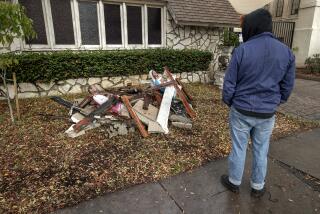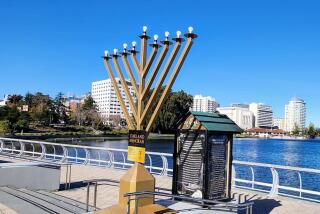Burial Box Linked to Jesus Is Damaged
- Share via
TORONTO — A 2,000-year-old casket, thought by experts to be the first proof of the existence of Jesus Christ outside of the Bible, was damaged en route to Toronto for its first public showing, museum officials said Friday.
The small limestone box, known as an ossuary, is thought to have contained the bones of James, the brother of Jesus. It is inscribed with the words “James, Son of Joseph, Brother of Jesus” and has been dated to about AD 63.
Toronto’s Royal Ontario Museum said the 20-inch-long ossuary arrived from Tel Aviv via New York on Thursday, but when it was opened several new cracks were showing on the back, end and front.
“In transit there must have been further impact to the piece, or some kind of damage ... we can’t really tell, but incipient cracks grew and other cracks appeared,” said Dan Rahimi, the museum’s director of collections management.
If the ossuary is authentic, it may be the most important find in the history of New Testament archeology: the earliest known nonbiblical reference to Jesus, some academics believe.
The owner of the box is reported to have bought it for a few hundred dollars in the 1970s and been unaware of its possible significance.
Its existence was revealed at a news conference in Washington on Oct. 21 by Biblical Archeology Review magazine.
Rahimi said the box was still intact but there was concern that new cracks, bigger than a hairline, could make it unstable.
One of the cracks runs through the latter part of the inscription “James, Son of Joseph, Brother of Jesus,” he said. The inscription is in Aramaic, a language used about 2,000 years ago.
Rahimi, an archeologist who has worked in the Middle East, believes the cracks can be treated in a museum’s conservation lab and will not diminish its overall importance.
The ossuary is valued at about $2 million, he said.
Museum officials said their expert on ceramic and stone examined the box Friday and prepared two proposals for the owner to consider. Digital images of the damage were also sent to him.
Rahimi said the owner, a private collector in Jerusalem, had packed and sent the ossuary to Toronto. He was described as being upset about the damage, but understood the issues.
Rahimi said among the treatments proposed was to inject an adhesive into the cracks that will fill in parts of the damage.
“The options are technical in a way, but one of the questions we will ask the owner is how much cosmetic work he will want done, if any, to the piece,” he said, adding that museum experts hoped to start work on the ossuary Monday.
Museum officials said they still planned to put the box on display from Nov. 16 to Dec. 29.
More to Read
Sign up for Essential California
The most important California stories and recommendations in your inbox every morning.
You may occasionally receive promotional content from the Los Angeles Times.










